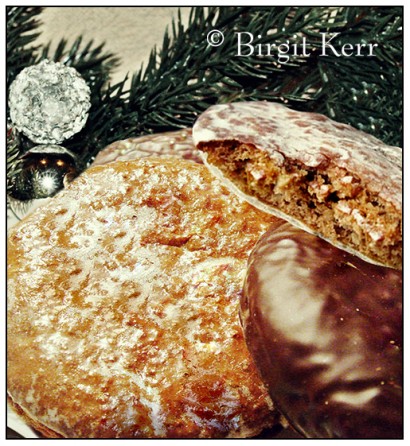One Review
You must be logged in to post a review.

One of the things I really look forward to making every year are Elisen Lebkuchen, also know as Nürnberger Lebkuchen.
These are not just ordinary gingerbread rounds though, far from it. They are moist, nutty, fragrant and utterly delicious.
Add Lebkuchen ingredients, except wafers, to a bowl and mix well. Cover bowl and let it sit in the refrigerator for 24 hours. It may seem a little runny at first, but it will thicken up quite a bit in the next 24 hours.
When you are ready to bake, preheat oven to 400ºF.
Lay out the baking wafers on a baking sheet, lined with parchment paper. Scoop equal amounts of the nut mix onto the wafers and smooth out. I find that the easiest way to get the round wafers uniform is to use an ice cream scoop. Scoop some nut mixture into your slightly moistened hands, make a smooth ball and then press it as a disc onto the wafer and smooth the edges down. Make sure that the disc is just slightly smaller than the wafer, as the dough will spread some.
Bake for 12–15 minutes or until Lebkuchen are lightly golden brown. It is important that they are not quite done in the middle though. Place them on a cookie rack to cool slightly.
Traditionally the Elisenlebkuchen are offered in 4 ways: with a thin sugar glaze, unglazed, with a thin dark chocolate glaze or with a thin milk chocolate glaze. You can offer them whichever way you prefer. In our family, we tend to favor the sugar-glazed ones, closely followed by the semi-sweet chocolate glaze, so I usually only do those two.
If you are going to be icing them with the sugar glaze, it is better if you do this when they are still a little warm. However, for the chocolate coating, they need to be entirely cooled. Try and brush the coating on as thinly as you possibly can!
If you have used baking wafers, just brush on a thin coat of chocolate coating or sugar glaze. Let completely dry and then store in a cookie tin. (If you didn’t use baking wafers, you will need to dip or brush your entire cookie. First a coat on the bottom, let dry, then a coat on the top of the cookie. This will also seal the moisture and flavors inside.)
Lebkuchen need to sit for a while to develop their prime taste and texture. They need a minimum of 10 days in that cookie tin, so take that into account when planning to make these! They will, however, keep for several weeks in a cookie tin. Personally, I think they taste the best after they have matured for about 2–3 weeks.
Notes:
• Click on the related blog post for further explanations and photos!
• One of the really important things in German Christmas baking is “Oblaten.” They are very thin baking wafers that are quite tasteless by themselves, but they have oh so many functions. First and foremost, they keep your cookies soft! Second, they help with uniform sizing and make your cookies slide off the baking tray so easily. But most importantly, they keep your cookies moist! This is important for Elisenlebkuchen, as they really need to sit for a while to reach their prime. I generally have some on hand, either from Germany or from local stores that carry German ingredients. I tend to use round because that is what I can get, but square or rectangular works just as well. And they can be cut to size really easily with a pair of scissors. They keep forever! I mean literally. I found some in my pantry from years ago and they were still perfectly fine! So if you get some, stock up! I also have a couple more recipes where these will come in quite handy. Should you not be able to find them but still want to try this recipe, there is a way around it. Granted it won’t work quite as well, but it is a passable substitute. I explain that in the directions.
• Chances are you can only get the hazelnuts whole. Grind them as fine as you can in your food processor. For the coarse chopped nuts, put the whole nuts in the food processor and pulse a few times. Then add the candied peel and pulse a few more times until the peel resembles finely chopped consistency.
One Comment
Leave a Comment
You must be logged in to post a comment.
rcgoheen on 10.25.2011
My aunt & uncle lived in Germany for several years and every year they would send a tin full of these cookies to my grandparents for Christmas. Since none of us can read or speak German we never knew quite what they were but my dad has always enjoyed them. I can’t wait to try to make these myself for Christmas this year!